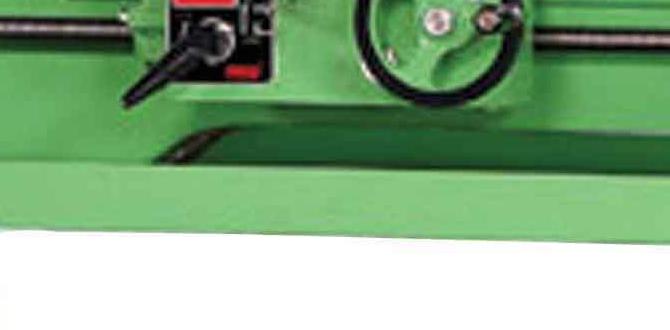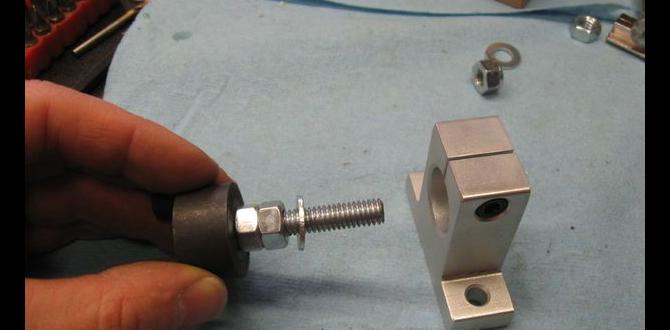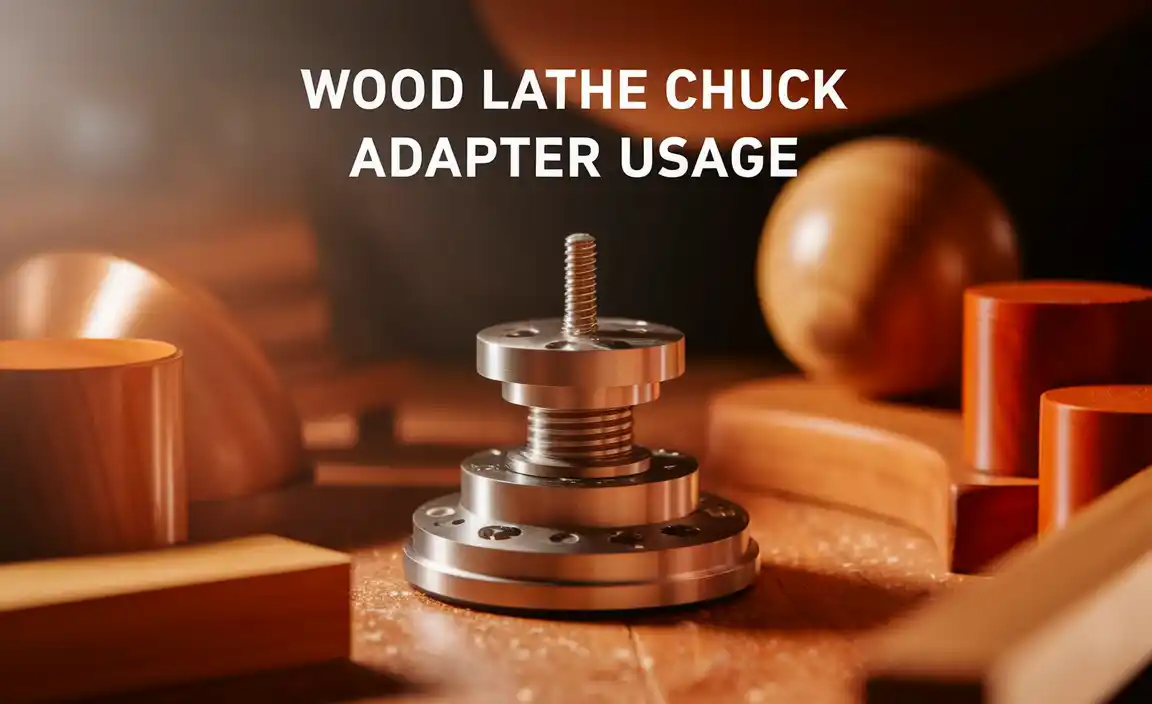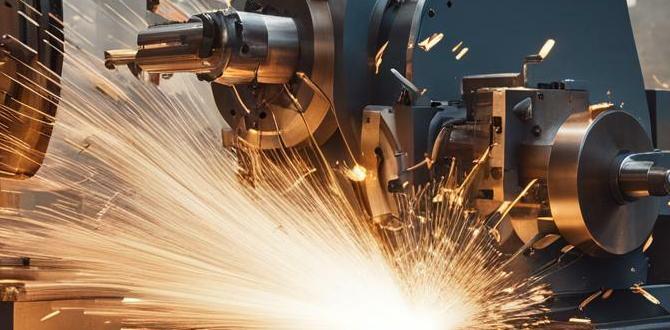Threading tools for a lathe are specialized cutters used to precisely cut screw threads onto cylindrical or conical workpieces. Mastering these tools is essential for creating fasteners, couplings, and many other functional parts, turning your lathe into a powerhouse for precision mechanics.
If you’re new to the lathe, the idea of cutting threads can seem a bit daunting. You might have seen those perfectly formed screw threads on manufactured parts and wondered how they’re made. The good news? It’s totally achievable with the right tools and a little guidance! Lathe threading tools are your ticket to creating functional, accurate threads for all sorts of DIY projects and repairs. Don’t let the complexity fool you; we’ll break it down into simple, manageable steps. Get ready to transform your metalworking skills and build confidence with every turn of the handle. Let’s dive into the wonderful world of lathe threading!
What Are Lathe Threading Tools?
At their core, lathe threading tools are specialized cutting bits designed to progressively remove material from a rotating workpiece to form a helical groove – what we call a screw thread. Unlike a standard turning tool that shaves off material to create a cylindrical shape, a threading tool has a specific profile that matches the desired thread form (like V-shape for a standard inch screw or a rounded form for Acme threads). The lathe’s lead screw and change gears work in harmony with the tool’s movement to create the precise pitch needed for the thread. Without the right threading tools, creating functional fasteners or mating parts on your lathe would be impossible.
Why Are They Important?
The ability to cut threads on a lathe is a fundamental skill in machining. It unlocks a vast range of possibilities: from creating custom bolts and nuts, repairing damaged threads, machining components for machinery, to even crafting decorative elements.
Imagine needing a specific length bolt for a project or wanting to create a specialized connector. With threading tools, you can precisely make these parts yourself. It’s not just about making things; it’s about understanding how mechanical parts interface and function. This knowledge is invaluable for anyone serious about metalworking, from hobbyists to aspiring engineers.
Types of Lathe Threading Tools
When you start looking into lathe threading, you’ll notice there are several types of tools. Each best suited for different kinds of threads and situations. Understanding these differences is key to choosing the right tool for your job.
1. Single-Point Threading Tools
These are the most common type of threading tool, especially for beginners. A single-point tool has a cutting edge that is ground to the exact profile of the thread you want to cut. Think of it like a very precise chisel shaped to create the V or Acme shape of a thread.
Key Characteristics:
- Cutting edge matches the thread form (e.g., 60-degree for Unified National or metric threads, 29-degree for Acme threads).
- Usually made from high-speed steel (HSS) or carbide.
- Requires multiple passes (cuts) to form the full thread depth.
- Versatile for various thread types and pitches.
When using a single-point tool, you’ll be making many shallow passes, advancing the tool slightly with each pass, to gradually cut to the correct depth. This method is slower but offers excellent control and a superior finish. It’s also the most economical way to start, as a single tool holder can often take various thread forms with interchangeable inserts.
2. Threading Inserts and Holders
Similar to single-point tools in function, threading inserts use a small, replaceable cutting tip (the insert) that is held in a specialized tool holder. Different inserts are available for various thread forms, pitches, and materials. This is a more modern and often more convenient approach.
Advantages:
- Easy Replacement: When an insert gets dull or chipped, you simply replace the insert, not the entire tool.
- Variety: A single holder can be used with a range of inserts for internal and external threads, different pitches, and thread types.
- Precision: Inserts are often made with very tight tolerances, ensuring accurate thread profiles.
- Material Options: Inserts come in carbide, ceramic, or coated HSS, allowing you to machine a wide range of materials efficiently.
For beginners, starting with a solid threading tool holder and a few common inserts (like a 60-degree insert for inch threads) is a great way to go. It simplifies tool management and ensures consistent results.
3. Die Heads
Die heads are a bit different. Instead of cutting a thread into a workpiece that’s spinning in the lathe chuck, they are used to cut external threads onto rods or studs. A die head contains multiple chaser blades (similar to small threading inserts) that rotate and cut the thread onto the workpiece as it’s fed into the die. They are often used in production environments for their speed and efficiency.
When to Consider Die Heads:
- Cutting external threads on relatively soft materials.
- When speed of production is a factor.
- When you need to thread material that is too long or awkward to hold in the chuck.
While effective, die heads require a specific setup and die holders on the lathe. They might be more advanced for a complete beginner compared to single-point tools.
4. Taps and Dies (Often Used Off-Lathe)
While taps (for internal threads) and dies (for external threads) are essential thread-cutting tools that many machinists use, they are typically operated by hand or in a tailstock/drill press setup rather than directly on the lathe’s main spindle for primary thread cutting. A tap cuts threads inside a pre-drilled hole, and a die cuts threads outside on a rod. Lathes can be used to perfectly center and prepare the workpiece for tapping, or to hold a die holder in the tailstock for threading a rod.
Lathe Application:
- Centering for Tapping: Use the lathe to drill a perfectly centered hole, ensuring a tap will cut straight.
- Chamfering for Tapping: Precisely chamfer the edge of a hole for easier tap entry.
- Threading Rods (using tailstock): Mount a die holder in the tailstock and use the lathe’s carriage feed to guide the die along a rod held in the chuck.
For introductory purposes, we’ll focus more on single-point tools and inserts, as they are the primary lathe-mounted tools for creating threads directly on the workpiece held in the chuck.
Essential Threading Tools and Accessories
Beyond the cutting tool itself, a few other items are crucial for successful lathe threading.
1. Threading Tool Holder
This is the device that holds your single-point threading tool bit or insert. It typically mounts into the lathe’s tool post. Threading tool holders are designed to hold the cutting tool at the correct angle and with sufficient rigidity to withstand the forces of cutting threads. They often have an adjustable block or clamp to position the cutting edge precisely.
2. Tool Post
The tool post is what holds your tool holder securely on the lathe. For threading, a sturdy quick-change tool post is highly recommended. It allows you to easily swap tools and maintain their height, which is critical for consistent thread cutting.
3. Lathe Change Gears or Quick-Change Gearbox
These gears are the unsung heroes of threading. The lathe’s change gears (or gearbox) are set up according to a chart provided by the lathe manufacturer to engage the lead screw with the headstock spindle at a specific ratio. This ratio dictates the pitch of the thread being cut.
For example, to cut 16 threads per inch (TPI), you would set the gears so that the lead screw turns exactly once for every revolution of the spindle.
4. Threading Dial Indicator
This is a critical aid for manual threading. It’s a dial mounted on the lathe that indicates the rotation of the lead screw. For most threads, you can re-engage the lead screw nut with the lead screw on certain lines indicated by the threading dial. This allows you to make multiple passes without needing to reverse the spindle. For threads with an even number of TPI, you can re-engage on any line; for odd numbers, on the same line; and for 1/2 TPI threads, on specific lines only.
5. Measuring Tools
Precision is everything in threading. You’ll need:
- Calipers (Vernier or Digital): For measuring thread diameter and pitch.
- Thread Gauges: To check the form (angle) of the thread.
- Micrometer: For precise measurement of thread depth or diameter.
6. Cutting Fluid
Threading generates heat and friction. Cutting fluid (or lubricant) is essential to cool the cutting tool and workpiece, reduce friction, prevent galling, and improve the surface finish of the thread. Use a suitable fluid for the material you are cutting (e.g., sulfurized oil for steel, specialized fluids for aluminum or plastics).
According to the Machining Data Handbook by the Machining Data Center, proper lubrication can significantly extend tool life and improve the quality of machined threads.
Understanding Thread Pitch and Form
Before you even touch a threading tool, you need to understand what you’re trying to create.
Thread Pitch
Pitch refers to the distance between adjacent threads. It’s typically measured in two ways:
- Threads Per Inch (TPI): This is common for inch-based systems (like in the US). For example, 1/2-13 means a bolt ~1/2 inch in diameter with 13 threads packed into every inch of length.
- Millimeters (mm): Used in metric systems. A thread might be specified as M10 x 1.5, meaning a metric thread with a major diameter of 10mm and a pitch of 1.5mm between threads.
The lathe’s change gears are set to achieve a specific TPI or mm pitch based on the spindle speed and lead screw pitch.
Thread Form
This is the shape of the thread’s cross-section. The most common thread forms are:
- 60-degree Unified National Form (UN, UNC, UNF): The standard for most bolts and screws in the US. The threading tool nose radii and flank angles must match this 60-degree form (with a slight truncation at the crests and roots) for proper engagement.
- Metric Thread Form: Also has a 60-degree angle but uses metric dimensions for diameter and pitch.
- 29-degree Square Thread: Very efficient for power transmission (like lead screws on machines). The sides are square.
- 29-degree Acme Thread: A more practical version of the square thread, with angled flanks (29 degrees) for better thread-cutting properties and resistance to stripping.
- Buttress Thread: Has a square-like profile on one side for high axial loads in one direction, with a relatively shallow angle on the opposite side.
Your threading tool must have a cutting edge that accurately replicates the desired form and angle. Using a tool with the wrong form will result in threads that don’t fit or aren’t strong.
How to Use a Lathe Threading Tool: Step-by-Step Guide
Let’s get practical. Here’s how to get started threading on your lathe using a single-point tool or insert. Safety first! Always wear eye protection and ensure your work is securely held.
Step 1: Prepare the Lathe and Workpiece
1. Mount the Workpiece: Securely mount your workpiece in the lathe chuck. Ensure it’s concentric and runs true.
2. Set Up the Tool Post: Mount a sturdy tool post. A quick-change tool post is ideal for easily returning the tool to the same height.
3. Mount the Threading Tool: Place your threading tool holder in the tool post.
4. Set Tool Height: The tip of the threading tool should be set exactly at the center height of the workpiece. This is crucial for cutting accurate threads. Use a center gauge or a height gauge to verify.
5. Set Tool Angle: For most threads, the threading tool should be aligned precisely parallel to the workpiece axis. For single-point tools and inserts, this often involves setting the tool holder at a specific angle in the tool post or the tool itself to match the thread flank angle. A tool setting gauge can help achieve this.
Step 2: Set Up the Lathe for Threading
1. Consult Your Lathe’s Manual: Each lathe is different. Find the threading chart in your manual or on your lathe. It will tell you which change gears to use and which lever positions (if applicable) to set for the desired TPI or metric pitch.
2. Engage Change Gears: Install the correct gears on the headstock and gearbox shafts as per the chart. Make sure they are properly meshed.
3. Engage the Apron Mechanism: Engage the half-nuts (or thread engagement lever) on the apron. This connects the carriage to the lead screw. Ensure the lead screw is clean and lubricated.
4. Set the Threading Dial: If your lathe has a threading dial, ensure it’s engaged with the lead screw.
Step 3: Set Up the Cutting Tool Pass
1. Position for First Cut: Move the carriage so the threading tool is just to the left of the workpiece where you want the thread to start.
2. Set Depth of Cut: Use the cross-feed handwheel to carefully bring the threading tool tip to the surface of the workpiece. You might feel a slight drag or see a faint scratch mark. Now, advance the depth a tiny amount.
For inch threads, a good starting point for the first cut is 0.002-0.004 inches. Subsequent passes can be increased gradually.
For metric threads, start with increments around 0.05-0.1 mm.
3. Set Compound Rest (Optional but Recommended): For most single-point threading, it’s highly recommended to angle the compound rest to either 29.5 or 30 degrees (depending on the thread form, 29.5 for 60-degree threads is common). This way, only one edge of the tool cuts on each pass, reducing friction and improving finish when you feed with the cross-slide. The compound rest doesn’t need to be moved much during the cut, only for depth.
Step 4: Make the First Threading Pass
1. Start the Lathe: Turn the headstock spindle on at a slow speed. For threading, slower is better. A good starting point is often around 100-200 RPM, depending on your lathe and material.
2. Engage the Half-Nuts: When the threading dial indicates the correct point (or when you decide to start for the first pass), engage the half-nuts lever firmly. The carriage will now be driven by the lead screw.
3. Feed the Tool: The carriage will move along the bed. Let the tool cut until it clears the end of the workpiece.
4. Disengage the Half-Nuts: As soon as the tool clears the workpiece, disengage the half-nuts lever. The threaded rod should be coming towards you as you advance the carriage manually.
5. Retract the Tool: Retract the threading tool using the cross-feed handwheel.
6. Reset for Next Pass: Position the tool back at the start of the thread.
Step 5: Subsequent Passes and Checking
1. Deepen with Cross-Feed: For the next pass, use the cross-feed handwheel to advance the tool by your desired depth of cut (e.g., another 0.002-0.004 inches). If your compound rest is angled, you are feeding with the cross-slide.
2. Engage and Cut: Re-engage the half-nuts at the same point you started the previous pass (using the threading dial’s guidance). Let the tool cut.
3. Disengage, Retract, and Repeat: Disengage the half-nuts, retract the tool, and repeat the process for each subsequent pass.
4. Check Progress: Periodically (every few passes), stop the lathe and use your thread gauge to check the thread form and angle. Use calipers to measure the thread’s major diameter. Compare this to your target dimension and the thread chart. Reduce the cutting depth as you get closer to the final size.
5. Finishing Pass: Make a final light “wiper” pass with very little depth of cut to achieve a smooth finish.
Step 6: Finishing the Thread
1. Final Measurement: Once the thread meets the required dimensions, make a final measurement.
2. Deburr: Lightly deburr the start and end of the thread if necessary.
3. Part Off (if applicable):** If you are parting off the threaded piece, do so carefully to avoid damaging the threads.
Threading Tools: A Comparative Table
| Feature | Single-Point Tool | Threading Insert & Holder | Die Head |
| :————– | :







